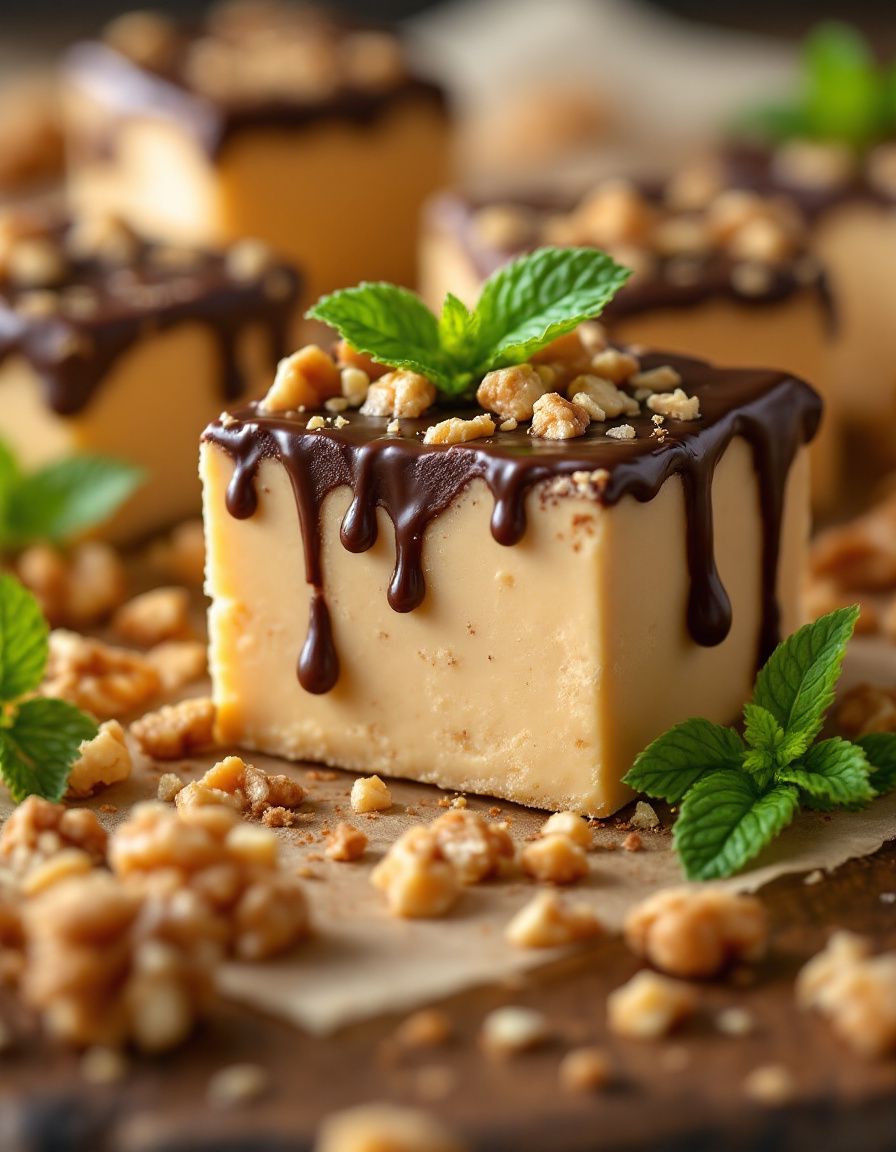Decadent Baileys Chocolate Cupcakes: Indulgence in Every Bite
Welcome to a delightful journey of flavors with these Baileys Chocolate Cupcakes! Each cupcake is a rich, chocolatey indulgence, perfectly enhanced by the smooth and creamy taste of Baileys Irish Cream. The combination of decadent chocolate cake with a hint of your favorite liqueur creates a treat that’s perfect for celebrations or a luxurious dessert. Whether you’re a chocolate lover or just looking for a sweet way to impress your guests, these cupcakes are sure to satisfy.
With a moist texture and a delightful frosting on top, these Baileys Chocolate Cupcakes are not just a feast for the taste buds, but also a visual delight. Their rich brown color, complemented by creamy white frosting, makes them irresistible. The aroma of fresh-baked chocolate and a hint of Baileys wafts through your kitchen, promising an unforgettable experience with every bite. Dive into the world of baking with these easy yet sophisticated treats, perfect for any occasion!
Quick Recipe Highlights
- Flavor Profile: These cupcakes offer a luscious chocolate flavor with creamy notes of Baileys, making each bite a perfect blend of sweetness and richness.
- Texture: Expect a soft and moist cake topped with velvety smooth frosting that melts in your mouth.
- Aroma: The delightful scent of chocolate mingles beautifully with the aromatic hints of Irish cream, enhancing your baking experience.
- Visual Appeal: The deep chocolate hue adorned with fluffy white frosting and chocolate shavings creates an enticing presentation.
- Skill Level Needed: Perfect for intermediate bakers, this recipe guides you through creating exquisite cupcakes with ease.
- Special Equipment: A standard muffin tin, mixing bowls, and a piping bag will make your baking process seamless.
Recipe Overview
- Difficulty Level: The moderate difficulty of this recipe comes from the frosting technique and ensuring the cupcakes are baked to perfection.
- Category: These cupcakes fall under desserts, perfect for after-meal indulgence or special occasions.
- Cuisine: Inspired by Irish flavors, particularly the use of Baileys, this recipe adds a unique twist to classic chocolate cupcakes.
- Cost: Generally budget-friendly, these cupcakes require common ingredients that can be used for multiple baking projects.
- Season: Ideal for any season, especially enjoyable during celebrations like birthdays and holidays.
- Occasion: Perfect for parties, intimate gatherings, or cozy nights at home with a sweet treat.
Why You’ll Love This Recipe
These Baileys Chocolate Cupcakes are not just a dessert; they are an experience. The intense chocolate flavor paired with the smooth, creamy Baileys enhances the taste profile beautifully, making each bite an absolute delight. The balance of sweetness from the frosting and the richness of the cake creates a perfect harmony, leaving you craving more. Whether enjoyed with a glass of milk or a cup of coffee, these treats elevate your dessert game to a whole new level.
Preparation is a breeze, with simple steps guiding you through the process. You can easily whip up a batch in less than an hour, making these cupcakes a perfect option for spontaneous gatherings or when you want to impress guests at the last minute. The versatile nature of Baileys allows you to play around with flavors, giving your cupcakes a personal touch while maintaining a delicious outcome every time.
Not only are these cupcakes delectable, but they also offer a unique spin on a traditional dessert that sparks joy in every bite. The festive nature of Baileys Irish Cream adds a celebratory aspect, making them perfect for birthdays and holiday gatherings. They also serve as a great conversation starter, as guests indulge in their rich flavor while sharing their love for dessert.
You’ll be thrilled to know that there are nutritional benefits associated with some of the ingredients used. Dark chocolate is known for its rich antioxidants, and the use of quality butter adds a creamy texture that elevates the flavor profile. Enjoying these cupcakes offers a chance to indulge without feeling too guilty when prepared in moderation.
Economically, making these cupcakes at home is a cost-effective alternative to purchasing gourmet desserts from a bakery. With basic pantry staple ingredients like flour, sugar, and cocoa powder, combined with the luxuriously indulgent addition of Baileys, you have a dessert that rivals those found in high-end restaurants at a fraction of the price. It’s an excellent way to treat yourself and your loved ones without breaking the bank!
Historical Background and Cultural Significance
The origins of Baileys Irish Cream trace back to 1974, when the first bottle of this beloved liqueur was produced in Dublin, Ireland. The idea was to create a rich and creamy drink that could be enjoyed on its own or as an addition to various recipes. Over the years, Baileys has secured its place in popular culture not only as a beverage but also as a key ingredient in baking and desserts.
Chocolate, on the other hand, has a rich history that dates back to ancient Mesoamerican cultures, where cacao beans were highly valued. The combination of chocolate and cream is timeless, and the indulgent mix creates a sense of luxury and celebration in many cultures. By combining these two elements, the Baileys Chocolate Cupcake becomes a cultural bridge, merging traditional ingredients with modern cooking.
As the recipe has evolved, variations incorporating different flavors such as espresso, mint, or seasonal ingredients have emerged. This versatility keeps the Baileys Chocolate Cupcake relevant and appreciated across generations, becoming a nostalgic favorite for many. Each edition offers a unique twist, showcasing the adaptability of the core recipe.
These cupcakes have also inspired numerous regional adaptations, with bakers worldwide incorporating local flavors and ingredients to make them their own. This shows how a simple recipe can transcend borders and traditions, bringing people together through the universal love of chocolate.
Ingredient Deep Dive
**Chocolate**: This beloved ingredient has been adored for centuries, often associated with celebrations and comfort. Rich in antioxidants, chocolate promotes heart health and boosts mood. When selecting chocolate for your cupcakes, opt for high-quality dark chocolate for the best results. Store it in a cool, dry place to keep it fresh, and consider using higher cocoa percentage chocolate for a richer flavor.
**Baileys Irish Cream**: Originating from Ireland, Baileys brings a creamy texture and flavor that enhances countless recipes. Its blend of rich cream and whiskey not only makes it a delightful drink but also an enriching baking ingredient. Store it in the refrigerator after opening for up to two years, ensuring it remains fresh for your baking needs. You can substitute it with a non-alcoholic Irish cream flavoring if preferred.
Common Mistakes to Avoid
- Overmixing the batter can lead to tough cupcakes, so mix just until combined for a tender texture.
- Not preheating the oven properly might result in uneven baking; always allow time for the oven to reach the desired temperature.
- Using cold ingredients straight from the fridge can affect the batter’s texture. Let eggs, butter, and cream come to room temperature for best results.
- Filling the cupcake liners too full can cause overflow; fill them about two-thirds for a perfect rise.
- Neglecting to check doneness can lead to underbaked or overbaked cupcakes. Use a toothpick inserted in the center to check for doneness.
- Skipping the cooling process entirely can ruin the texture; let your cupcakes cool completely before frosting.
- Not using quality chocolate can impact the overall flavor, so choose premium brands when possible.
- Frosting cupcakes when they are warm can lead to melted frosting, so always wait until they are completely cooled.
Essential Techniques
**Baking the Cupcakes**: It’s crucial to follow the recipe for correct oven temperature and baking time. Preheating the oven ensures even baking, and using an oven thermometer can help if you suspect your oven runs hot or cool.
**Frosting Application**: Applying frosting can be a fun but tricky technique. Use a piping bag for a professional look, and make sure cupcakes are completely cooled. To prevent runaway frosting, start at the center and swirl outward.
Pro Tips for Perfect Baileys Chocolate Cupcakes
1. Opt for high-quality dark chocolate for the best flavor. It truly makes a difference!
2. Incorporate espresso powder for an added depth of flavor that complements the chocolate perfectly.
3. Always measure ingredients accurately; baking is a science!
4. Experiment with different flavored extracts for the frosting, like vanilla or almond, to change up the taste.
5. For added crunch, top with crushed nuts or chocolate shavings.
6. Allow your cupcakes to cool completely on a wire rack to prevent sogginess.
7. Store frosted cupcakes in the fridge to prolong freshness, but allow them to come back to room temperature before serving for best flavor.
8. Have fun decorating! Use colorful sprinkles or edible glitter for a festive touch.
Variations and Adaptations
If you want to switch things up, consider adding a filling of ganache or raspberry jam in the center for a surprise element. For a seasonal twist, try adding pumpkin spice for fall-themed cupcakes or peppermint extract for holiday celebrations.
Additionally, if you prefer a gluten-free version, substitute regular flour with a gluten-free blend. For a lighter option, reduce the sugar slightly, or use coconut sugar for a healthier alternative.
Don’t forget about frosting alternatives! A whipped cream topping can replace traditional frosting for a lighter finish, while a tangy cream cheese frosting would complement the sweetness beautifully.
Lastly, you can change the presentation by placing the cupcakes in decorative liners or topping with fresh fruits like strawberries or raspberries for a vibrant look.
Serving and Presentation Guide
Presentation can elevate your Baileys Chocolate Cupcakes. Use vibrant cupcake liners or decorative plates to enhance their visual appeal. Garnish each cupcake with a sprinkle of cocoa powder, a drizzle of chocolate sauce, or a dusting of powdered sugar for an elegant touch.
Consider offering a small cup of extra Baileys on the side for an indulgent feel, or present each cupcake alongside a scoop of vanilla ice cream for a delightful pairing. For gatherings, arrange the cupcakes on tiered stands for a beautiful display.
Wine and Beverage Pairing
Pair your Baileys Chocolate Cupcakes with a rich, velvety red wine like a Cabernet Sauvignon or a sweet dessert wine such as Port to complement the chocolate notes. If you’re looking for non-alcoholic options, serve these cupcakes with a glass of cold milk or a warm cup of coffee to enhance the flavors.
You can also offer a creamy vanilla latte for a coffeehouse feel or a luxurious hot chocolate to top off the chocolate experience. Ensure that all beverages are served at appropriate temperatures to fully enjoy the flavors of both the cupcakes and the drinks.
Storage and Shelf Life
To store your delicious Baileys Chocolate Cupcakes, keep them in an airtight container at room temperature for up to three days. If you’d like to store them longer, refrigerate for up to a week. Be sure to allow them to come to room temperature before serving, as cold cupcakes can mask their flavors.
If freezing is necessary, freeze unfrosted cupcakes in a single layer, then transfer to an airtight container once solid. They’ll last up to three months. When ready to enjoy, let them thaw in the fridge before frosting and serving.
Make Ahead Strategies
For a stress-free baking experience, consider preparing the cupcake batter a day ahead of time and refrigerating it. Allow the batter to come to room temperature before baking. The cupcakes themselves can also be made ahead of time and stored, as mentioned, ensuring they are fresh when it’s time to serve.
You might also prepare your frosting in advance and store it in the refrigerator. Just make sure to bring it to room temperature before applying it to the cupcakes for easy spreading or piping. Planning these steps can save you time and effort, allowing you to enjoy the event more!
Scaling Instructions
If you want to make a smaller batch of these delightful cupcakes, simply halve all the ingredients and adjust your baking time accordingly, checking a few minutes earlier to make sure they don’t overbake.
To double or triple the recipe, consider using multiple muffin tins and larger mixing bowls. Remember that increasing the quantity may affect the baking time, so always keep an eye on them in the oven.
For gathering larger crowds, baking in multiple batches can also be beneficial, allowing for even baking and better control. Have fun scaling to make the most of these indulgent treats!
Nutritional Deep Dive
Each Baileys Chocolate Cupcake provides a satisfying blend of macronutrients, featuring carbs from the flour, fats from butter, and a bit of protein from eggs. The nutritional content can vary based on ingredient choices, such as using whole grain flour or lowering the sugar content.
Micronutrients such as iron and magnesium are present in the chocolate, while the Baileys Irish Cream brings in some calcium thanks to the dairy content. It’s wise to enjoy these cupcakes in moderation, but they do provide a unique blend of flavors and nutrients in a small, delicious package.
Dietary Adaptations
For those needing gluten-free options, simply swap out regular flour for a gluten-free blend that measures cup-for-cup. To create a dairy-free version, use coconut cream for frosting and replace butter with a dairy-free alternative.
If you want vegan cupcakes, replace eggs with flax eggs, and use almond or oat milk in place of dairy milk. For a low-carb or keto version, consider using almond flour and sugar substitutes while adjusting the baking time accordingly.
Each variation allows you to maintain a rich and satisfying flavor profile while catering to specific dietary preferences and needs, making these cupcakes versatile for any gathering.
Troubleshooting Guide
If your cupcakes come out too dense, it could be due to overmixing the batter or improper ingredient measurements. Make sure to mix just until combined and always check your measurements with care.
Flavor balance can sometimes be off; if your cupcakes taste too sweet, reducing sugar slightly can help bring out the richness in the chocolate.
If the texture of your frosting is too runny, ensure your butter is at room temperature and not melted. Chill the frosting briefly if needed to thicken it up. Likewise, if it’s too thick, add a splash of cream to adjust its consistency.
Baking problems may also arise if your oven temperature is not calibrated correctly. An oven thermometer can aid in identifying the perfect baking environment.
Recipe Success Stories
Many home bakers share success stories about their attempts at making Baileys Chocolate Cupcakes, highlighting their easy preparation and delicious outcome. Feedback often praises the balance of flavor and texture, making them a hit at parties.
Readers have also demonstrated creativity, like mixing in local flavors or trying different frostings, which add a personal touch to the cupcakes. These variations not only showcase individual flair but also inspire others to experiment with the recipe.
Photography tips from our community indicate that good lighting and showcasing the cupcakes with garnishes can significantly elevate the presentation, contributing to their appeal online and in personal collections.
Frequently Asked Questions
1. Can I use milk chocolate instead of dark chocolate?
No, for a more balanced flavor, we recommend using dark chocolate to enhance the richness of the cupcakes.
2. How can I make these cupcakes ahead of time?
You can prepare the cupcake batter or freeze the baked cupcakes without frosting. Thaw and decorate just before serving.
3. What if I don’t have Baileys?
You can substitute it with any Irish cream liqueur or use a non-alcoholic Irish cream flavoring for similar results.
4. What’s the best way to store baked cupcakes?
Keep them in an airtight container at room temperature for 3 days, or refrigerate them for up to a week.
5. Can I freeze the cupcakes?
Yes! Unfrosted cupcakes can be frozen for up to three months. Just wrap them tightly.
6. Are these cupcakes kid-friendly?
While the cupcakes contain Baileys, you can make a non-alcoholic variant suitable for kids.
7. What’s the difference between buttercream and frosting?
Buttercream is a type of frosting made primarily from butter and sugar, while frosting can be lighter and whipped.
8. How do I make the frosting fluffy?
Ensure your butter is at room temperature and beat it well before adding powdered sugar for a fluffy texture.
9. Can I add fruit to the cupcake batter?
Yes, adding diced fruits like strawberries or raspberries can introduce fresh flavors and moisture.
10. What’s a good temperature to serve the cupcakes?
For the best flavor, allow them to reach room temperature after being refrigerated and before serving.
Additional Resources
For more delicious recipe ideas, check out our site for related dessert recipes that include chocolate, cupcakes, and Baileys-inspired treats. We also provide guides on baking techniques and ingredient usage for successful outcomes every time.
Enhance your baking skills with our comprehensive technique guides that cover everything from understanding different types of flour to mastering the art of frosting, ensuring you feel confident in the kitchen.
Join the Conversation
We love hearing from our baking community! Share your Baileys Chocolate Cupcake creations on social media for a chance to be featured. Discuss your variations and let us know how you’ve made this recipe your own.
Don’t forget to leave reviews and feedback on your baking journey, as your experiences help other bakers with their culinary endeavors and inspire new adaptations!
The Recipe
Baileys Chocolate Cupcakes
Serves: 12 cupcakes
Prep Time: 20 mins
Cook Time: 25 mins
Total Time: 45 mins
Kitchen Equipment Needed
- Muffin tin
- Piping bag
- Mixing bowls
- Whisk
- Cooling rack
Ingredients
- 1 cup all-purpose flour
- 1 cup sugar
- 1/2 cup cocoa powder
- 1/2 cup unsalted butter, softened
- 2 large eggs
- 1/2 cup Baileys Irish Cream
- 1/2 cup buttermilk
- 1 tsp baking powder
- 1 tsp baking soda
- 1/2 tsp salt
- 1 tsp vanilla extract
- 1/2 cup chocolate chips (optional)
Directions
- Preheat your oven to 350°F (175°C) and line muffin tins with cupcake liners.
- In a large bowl, whisk together flour, cocoa powder, baking powder, baking soda, and salt.
- In another bowl, cream the butter and sugar until light and fluffy. Add the eggs, one at a time, mixing well after each addition.
- Stir in the Baileys, buttermilk, and vanilla extract until smooth.
- Gradually fold the dry ingredients into the wet mixture until just combined, being careful not to overmix.
- Evenly distribute the batter into the cupcake liners, filling each two-thirds full. If using chocolate chips, sprinkle on top before baking.
- Bake for 20-25 minutes or until a toothpick inserted into the center comes out clean. Allow to cool on a wire rack.
- For the frosting, beat together softened butter and powdered sugar, adding a splash of Baileys until you achieve a smooth consistency.
- Frost cooled cupcakes and decorate as desired.
Recipe Notes
- For a richer frosting, add melted chocolate to the buttercream.
- Store cupcakes in an airtight container for freshness.
- Feel free to experiment with different chocolate types or liqueurs!








